BIOGRAPHY OF K.L. SAIGAL
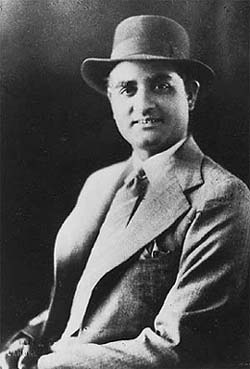
Kundan Lal Saigal was a singer, and actor in the early days of the Indian cinema. He is generally acknowledged to be the first Bollywood superstar. In his 15 year career, he acted and sang in 36 feature films, a number of shorts, and numerous of disks.
K.L. Saigal was born April 11, 1904 in Nawa Shahar in Jammu. His father was named Amar Chand and he worked in the service of the Raja of Jammu and Kashmir. His mother was named Kesar Bai. Kundan was one of five children.
Formal music education was not easily obtainable in those days. The obstacles of class, community, and economics kept many people from having such benefits. Saigal too felt these obstacles. Never-the-less, the young Saigal did what ever he could to learn music. Initially it was singing and acting in the local Ram Lilas. He also spent much time at the shrine of the Sufi saint Salamat Yusef, there he sang and practiced along with other musicians and devotees. It is said that as a youth he used to sneak near the house of a local tawaif so that he could hear her sing; afterwords he would imitate what he heard.
As a young man he had several occupations. After he dropped out of school, he worked for a while as a railway timekeeper. Later he worked as a typewriter salesman; this later occupation gave him the opportunity to travel widely in India.
All the time that he was travelling in his job, he was singing on an amateur basis. He used to sing in gatherings with friends and met many people. On one occasion he met Meharchand Jain; he would become one of Saigal's early friend and supporter. In his travels, he also met B.N. Sircar the founder of New Theatres. It is said that it was Sircar, who persuaded Saigal to go to Calcutta.
Saigal's life in Calcutta was steeped in music. Although he briefly worked as a hotel manager, his interest was in the music scene. He was a frequent participant in mehfils. He also recorded a number of discs of songs written and arranged by Harishchandra Bali. These were released through Indian Gramophone Company. His reputation as a singer was growing.
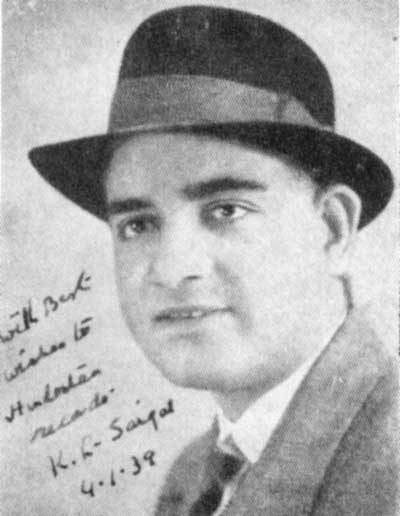
Publicity Photo of Kundan Lal Saigal
The film business at that time was in the midst of a shake-up. The talking picture was just introduced, so the film companies were clamouring for actors that knew how to sing. We must remember that these were the days before the custom of "playback" singing came into fashion. The actors and actresses sang their own songs, and musical ability was considered and important prerequisite for a successful film career.
Saigal's immensely popular music recordings proved to be his stepping-stone into the films. While in Calcutta, Saigal was introduced to R.C. Boral. It was Boral who signed Saigal to a contract with New Theatres. He was payed Rs200 a month to work on their films. His first film to act in was the Urdu film "Mohabbat Ke Ansoo" (1932). Thereafter he had roles in "Subah Ke Sitare", and "Zinda Laash". These were released in 1932. These were by no means hits, but they did demonstrated that Saigal had what was necessary in the film industry.
During this period Saigal continued to make disks. Hindustan Records Company of Calcutta brought out several disks, of which Jhulana jhulao attracted much attention from the public.
He continued to sing and act in a number of films. However the film that made him famous was "Chandidas" (1934). After that he had many offers to do more films, but the one which earned him a place in film history was "Devdas" (1935). After the phenomenal success of "Devdas", there was no doubt that Saigal was a formidable entity in the film industry.
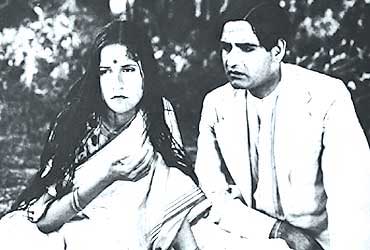
Jamuna and K.L. Saigal in scene from Devdas (1935)
It was during this period that his personal life developed as well. In 1935 he married Asha Rani. together they had three children. There was a son named Madan Mohan (no connection to the director of the same name), and two daughters, Nina (b. 1937) and Bina (b. 1941).
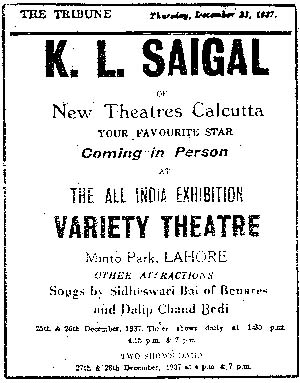
Advert for Saigal program
While in Calcutta, Saigal became proficient in Bengali. This allowed him to sing and act in a number of Bengali films. He even had the distinction of being the first non-Bengali that Rabindranat Tagore would allow to record his work.
But this was a transitional period in the history of the Indian film industry. The centre of the Hindi film industry was shifting from Calcutta to Bombay; so Saigal moved with it. He moved to Bombay in December of 1941, and there began to work with the Ranjit Movietone Company. There he did films such as "Bhakta Surdas", "Tansen", "Kurukshetra", "Omar Khayyam", "Tadbeer", "Shahjahan" and "Parwana".
But unfortunately alcoholism was gripping Saigal. It is said that in the years before his death, he was unable to sing or perform without first having a drink. This was affecting both his health as well as his work. He developed cirrhosis of the liver. As his health deteriorated, Saigal expressed the desire to be with a saintly man in Jalandhar, but his family objected; they wanted him to take the assistance of one of the best doctors in Bombay. A compromise was reached whereby the doctor would accompany Saigal to to Jalandhar. However medical treatment was to no avail; he passed away on January 18th 1947 in Jalandhar. Saigal was only 42 years old.
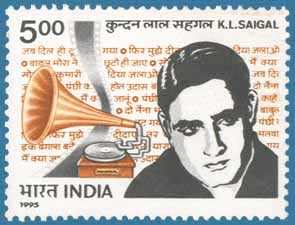
KL Saigal Stamp
Selected Video
© 1998 - 2021 David and Chandrakantha Courtney
For comments, corrections, and suggestions, kindly contact David Courtney at [email protected]
